Our journey began at daybreak in the deep forest interior of Western North Carolina's mountain country; a two-hour drive took us to the town of Townsend, in Blount County, Tennessee. As we drove through upper Graham County in North Carolina, the sun rose slowly casting a great shadow over the mountain narrows. Curve after curve rolled by as we continued northward along highway 129, following a path between the beautiful blue mountain waters of Lake Santeetlah and Lake Fontana. Reaching Deal's Gap at the North Carolina and Eastern Tennessee state line, we began our descent along the Tail of the Dragon, locally known as "the Dragon." The metaphoric "tail" is a mere 11 1/2 miles long route, consisting of 318 tight curves heading due west. Our upper bodies moderately sway from left to right as we took on each tight turn.
Mrs. Highlander and I exited "the Dragon" along the banks of the Little Tennessee River, we emerged onto less tightly wound curves but curves just the same. Reaching the northern shoreline of Chilhowee Lake, we soon accessed Tennessee's, Smoky Mountains "Foothills Parkway." This section of the Foothills Parkway follows along the top of an elongated ridge with spectacular views of the Tennessee River Valley to the west and the magnificent Great Smoky Mountains National Park hugging closely to the Parkway to the east. That's "black bar' country" to you city folks, and our destination for this feature Blue Ridge Highlander story.
We exited the Foothills Parkway at state 73 going east; up ahead a few more miles is our destination just outside the popular tourist town of Townsend in Blount County, Tennessee. Cradled below the giant Smoky Mountains, just off the beaten path, is the headquarters of Appalachian Bear Rescue (ABR), a not-for-profit organization where our adventure begins. Relieved just to get my hands off the steering wheel and the luxury of stretching our legs, we were immediately greeted with a great big smile of our lovely host and curator Lisa L. Stewart of Appalachian Bear Rescue.

The sun rising over the enormous summits of the Great Smoky Mountains glistened against the dew soaked grass as Lisa kindly welcomed Mrs. Highlander and I into her home office. It's necessary for the curator to live on the grounds in order to be available to tend to the needs of her bear guests 24/7. Lisa is not only the curator for the Appalachian Bear Rescue center; she has been a wildlife rehabilitator since 1990 possessing permits from both Tennessee and Mississippi. Lisa holds a degree in Animal Science and is a member of East Tennessee Wildlife Rehabilitation Council; she also conducts educational outreach programs for Appalachian Bear Rescue.
Inside the curator's home office, we were greeted by Anne Allison and Kathy Sherrard of NC, who are Directors on the ABR Board and the "traveling" team of educators that share the ABR mission and bear safe facts in schools, with civic organizations and for many annual wildlife events. Anne and Kathy are retired educators who worked with numerous animal welfare organizations before coming to ABR, where they now offer their dedication and expertise.
As we waited for our official Wildlife Manager to arrive, we had the opportunity to share stories over cookies and coffee, a welcome 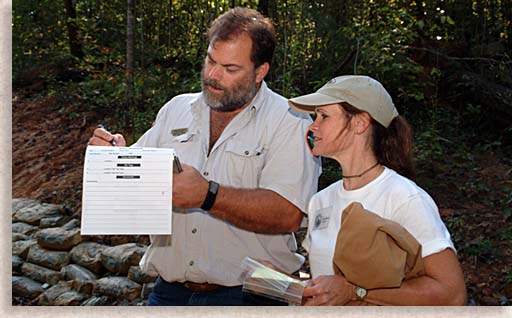 treat after a long, intense early morning drive. Within moments, a large burly, furry figure made his way through the front door and tossed his smiling hat into the ring along with the rest of us. J. David Whitehead, our official regional wildlife manager, joined our coffee and cookie frenzy while sharing his background with Mrs. Highlander and I; everyone else was well acquainted with David and needed no introduction.
treat after a long, intense early morning drive. Within moments, a large burly, furry figure made his way through the front door and tossed his smiling hat into the ring along with the rest of us. J. David Whitehead, our official regional wildlife manager, joined our coffee and cookie frenzy while sharing his background with Mrs. Highlander and I; everyone else was well acquainted with David and needed no introduction.
David is with the Tennessee Wildlife Resources Agency (TWRA) and is the Wildlife Manager II of the South Cherokee and Tellico Lake Wildlife Management Areas. David has been a Wildlife Manager with the state of Tennessee for over 20-years. Currently, he manages two Wildlife Management Areas totaling 200,000-acres in Monroe County, Tennessee. David's mission today is to relocate two rehabilitated black bear yearlings from ABR into the wilds of the Cherokee National Forest, and the Highlander has the privilege to witness this feat.
This team of five players were about to begin their journey with David leading the way, his big bear-like composure, is liken to a "Grizzly, Black Bear Adams." David would personally prep the two yearling bears, and would transport them into the mountain wilderness of his official domain.
Lisa, with her devoted motherly curator nature assisted David in preparing the yearlings for their journey, with some help from all the "players!"
Yearlings are young bears between the ages of cub and adulthood, about eighteen months old. Anne and Kathy, our volunteer bear educators, would join the trip to further their knowledge of the process, while Mrs. Highlander and I joined in for a thoroughly enjoyable experience and the opportunity to share this experience with our Highlander readers.
For years we wanted to create a section within the Highlander entitled "Kings of the Mountains, In Pursuit of the Black Bear." As with all of our feature stories we do a lot of research and whenever possible, we get involved so that our readers can hopefully feel our first hand experiences. Until now, I have held back on what made this particular journey so special. This unique experience was more than Mrs. Highlander and I had expected, and one we will always remember.
The joy of this part of the story is in itself unique, the Appalachian Bear Rescue organization's mission is to rescue black bear cubs, rehabilitate, release into the wild and/or relocate them. Their release occurs once they become yearlings, at approximately fourteen months to two years old. That's the normal healthy age for young bears to set out into the wilds on their own. Female bears mate every two years and it necessary for their existing young to leave their mother's den so she can make room for her new litter of cubs. At the time of their departure, the yearlings at Appalachian Bear Rescue averagely weigh between 100 to 150 pounds, plenty big enough to fend for themselves.
Appalachian Bear Rescue receives cubs that are abandoned, either by the mother bear's death, her unforeseen rejection or for unknown reasons when they get separated from their mother and are too young to care for themselves. Mother bears, or sows as they're known, have litters of 1 to 3 cubs.
All cub bears entering the facility are given a complete physical by qualified veterinary personnel from the University of Tennessee's College of Veterinary Science to determine their present condition. After his or her exam, each cub receives a number and a name. UT's veterinarians also assist with the cubs' future health care needs for ABR.
Today's bear crew members will have a short stroll down an unpaved road from the office to the bear habitat where today's release work begins.
It is important to understand that this special bear habitat is not open to the public for a good reason. Most of these little guy and gal bears, are expected to be released back into the wilds of their native homelands instead of zoos, to live a natural bear life, the way the Good Lord had intended. The ones placed in the care of qualified zoos are done so due to the fact that they are unlikely to be able to survive in the wild on their own once they became yearlings.
The strict "hands off" program at ABR is for the purpose of preparing these cubs to return to the wild with their natural wild nature intact. "Imprinting," is a term used when cubs are overly handled by well meaning humans, causing the cubs to become "habituated bears."
Habituated bears are the ones that look to humans to supply their needs, abandoning their natural instincts. Habituated bears in the wild live shorter lives, and breed offspring that also become habituated bears. The habits and lifestyles of habituated bears can also lead to diseases or deficiencies within the black bear community that can largely affect the general black bear population. "Please don't feed the bears," is not a request, it's a must.
The black bear habitat at Appalachian Bear Rescue is located in a predominately-wooded area below the curator's office. The large cub habitat is completely surrounded by a high chain link fence; its walls are covered with large black blinds from top to bottom. Even here it's necessary to segregate their little cub world from the human world in order to maintain a natural wildness in the cubs. This is essential for their development to keep them as much uninfluenced by their human caretakers as possible.
For the sake of the bears, the public can't see these cubs personally, though you can enjoy seeing their photos and learn more about the cubs by subscribing to Appalachian Bear Rescue's newsletter, "Bear Tracks" and by going to their educational seminars and visiting their website: www.appalachianbearrescue.org
As Mrs. Highlander and I approached the compound, we could detect the cubs' movements and sounds. Peeking in through the slits in the black blinds, we witness one of the most unique and precious sights we have ever seen. It was like a forest filled with little cub bears, we counted between 10 to12 cubs in all.
The large compound was like a forested daycare center for wildlife toddlers playing alone, sitting together in groups interacting with one another making oral sounds, climbing, wrestling, napping and snacking on fruits and nuts. It was like watching bear toddlers in a Montessori Preschool. They were all so involved with their own chosen task.
So tempted was I to start photographing but I restrained myself in respect of the ABR "hands off " policy. Understanding the permanent harm to the cub's future welfare was the only thing that kept me from wanting to jump in and play with them. Well actually I did want to, I just knew better.
Again, the Appalachian Bear Rescue's strict "hands off" approach prevents the bear cubs from becoming habituated, or dependent on people including becoming too comfortable just seeing humans. Bear cubs are just like little children, puppies and kitties that all starve for attention. These little ones need their personal "me time" to develop for a challenging future that lies ahead in the wild.
David and Lisa entered the main gateway and accessed another part of the compound where the two older yearlings lived separated from the toddler cubs; the yearlings' compound is within the main compound, separated by a fence down the center of the main compound.
Mrs. Highlander and I remained in an outdoor foyer between two security gates, while David and Lisa prepared the two lucky bears that who were heading back home to the wild. As we stood waiting patiently peeking through the tarp, a cub noticed our slight movement, approached us from behind a slit in the tarp making bear grunts, groans and blowing noises to get our attention. We moved back from the fence in order not to encourage the "little tike" but he or she wouldn't have any of it.
The bear cub began reaching under the fence to get our attention; we didn't give in to its plan. After a while, the cub pulled its paw back only to reappear pushing a small rock under the fence, the cub left the rock and pulled his paw back. The cub then retrieved the rock only to once again push the rock under the fence by us. The cub did this a couple more times until it became evident he wanted to "play rock with us." We are familiar with playing ball with dogs and children; yet, we've never been invited to play rock with a bear cub, and we knew better than to start now. Next thing you know, the cub would want to go home with us, that's a sweet idea but before long the cub would become a 350-pound, "eats like a bear pet," not to mention that there might also be a few other issues with our Highlander neighbors.
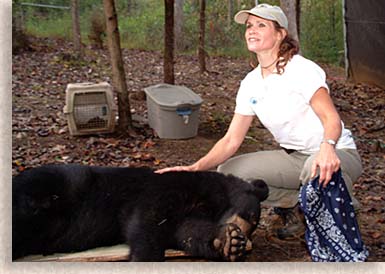 About this time, Lisa reemerged from the yearling compound and invited me, not Mrs. Highlander (ha-ha), into the large yearlings compound to help carry out the sedated young bears. Both yearlings had already been properly tranquilized before I entered the adjacent compound, yet at 130 plus pounds, there was more bear butt to carry out than in-house muscle available, "ah" the privilege of being the media. With David armed with his trusty dart gun, Lisa and I felt confident as the two yearlings lay sleeping on the ground, besides if I didn't cooperate I might soon find myself darted and sleeping with the bears. I weigh well over a hundred and thirty pounds, who would carry me out? I must mention the TWRA wildlife regulations prohibit volunteers from working with the bears directly, yet I am the media, which offered me special privileges, and this was safer than foreign war coverage. I felt as though I was temporarily deputized for this special, young, black bear rescue roundup.
About this time, Lisa reemerged from the yearling compound and invited me, not Mrs. Highlander (ha-ha), into the large yearlings compound to help carry out the sedated young bears. Both yearlings had already been properly tranquilized before I entered the adjacent compound, yet at 130 plus pounds, there was more bear butt to carry out than in-house muscle available, "ah" the privilege of being the media. With David armed with his trusty dart gun, Lisa and I felt confident as the two yearlings lay sleeping on the ground, besides if I didn't cooperate I might soon find myself darted and sleeping with the bears. I weigh well over a hundred and thirty pounds, who would carry me out? I must mention the TWRA wildlife regulations prohibit volunteers from working with the bears directly, yet I am the media, which offered me special privileges, and this was safer than foreign war coverage. I felt as though I was temporarily deputized for this special, young, black bear rescue roundup.
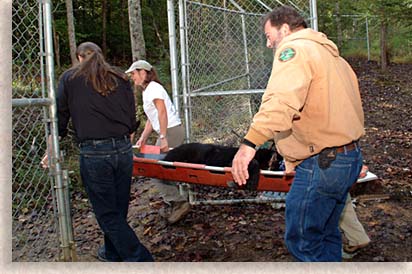 With the bears securely on the stretchers, we lifted and carried the furry ones out one at a time. In the photo of the three of us carrying the stretcher, David is the one in the obvious wildlife full dress uniform; the cutie in the cap is Lisa our curator, and the pack monkey with the long locks is me (the Highlander.) Making myself available for the heavy work placed the camera in Mrs. Highlander's trusted hands.
With the bears securely on the stretchers, we lifted and carried the furry ones out one at a time. In the photo of the three of us carrying the stretcher, David is the one in the obvious wildlife full dress uniform; the cutie in the cap is Lisa our curator, and the pack monkey with the long locks is me (the Highlander.) Making myself available for the heavy work placed the camera in Mrs. Highlander's trusted hands.
Outside the fenced in area, David began to prepare the yearling for their release. These two yearlings (we'll call bears 1 and 2, to protect their wilderness identities) are in excellent condition for release. Getting a paw print photo release was out of the question since they were fast asleep and it was unethical for me to ink their paws and press it on a release form.
Concerned about the ongoing commotion outside their compound, a couple of the cubs climb up one of the trees in the enclosure for a better look at all the hub-bub going on outside. After watching for a while they did what all cub bear do in trees, they played tag and see if you can catch me games with the other cubs while climbing up and down the tree.
David continued his preparatory work on the two yearlings as we watched on. Bear 1 weighed in at 146 pounds and Bear 2 weighed in at 151 pounds, both strong and healthy. In order to follow the life of these bears in the wilderness, it is necessary to tag and to record their personal identification for future study. For ID purposes, the yearlings were tattooed and ear tagged; for DNA identification hair samples were taken. With skilled pro-hands our wilderness wildlife leader, David carried out his duties proficiently as we watched on with amazement. The yearlings' paws were examined and mighty big paws they were, bears have impressive front paw dexterity and are great at manipulating small items.
While the yearlings were still tranquilized, we carried the stretchers bearing the bears one at a time up to the transport truck, then loaded them into their traveling accommodations, not an easy task, the yearlings didn't seem to mind at all. Come to think about it, it was as though we were honoring the young bears by carrying them on our shoulders en-route to their royal destination.
After securing the yearlings safely in the trucks separate cages, we all headed into the ABR office to freshen up and take in some more cookies and coffee. About 15-minutes later, we headed out to the wildlife truck where both yearlings were now up and about in their cages. Lisa hosed down the yearlings to keep them cool on their trip, and said her goodbyes thanking us all for coming. Then she turned to her departing bear family members and wished them well on their journey with a loving look in her eye, separation is always difficult for human den mothers.
Lisa stood in the driveway waving goodbye, curator/mama bear had to stay behind, the cubs' day care center needed its den mother's ever nurturing attention. David led the way, followed by Mrs. Highlander and I in our vehicle and Anne and Kathy in theirs.
Like a parade of bear lovers behind the wheels of our vehicles, we headed out for the wilderness; the drive along the highway was eventful. It was quite a ways from the town of Townsend to the Tellico Ranger and Wildlife District of the Cherokee National Forest. Along the way, we passed through the sizable town of Marysville in Blount County, just south of Knoxville, Tennessee. Drivers along either side of our three-vehicle bear parade marveled at the bears we were escorting. Kids and adults alike smiled, waved and pointed, it was quite a treat for them and for us. In Marysville, our burly mountain man wildlife manager needed to make a "hungry as a bear pit stop" for himself before going on. Driving the 2 bears through the drive up window had to be the highlight and talk of the week.
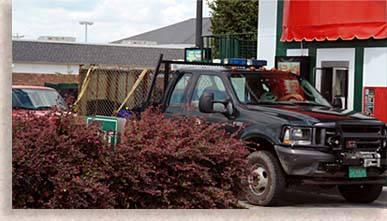 |
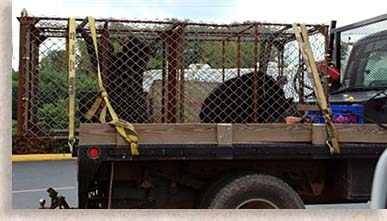 |
Everywhere we went folks kept pointing and giggling at our traveling circus, the yearling played along, rising up waving their big paws incidentally in the air like the guests of honor they were. It would be their last performance in public before being release into the solitude of their ancestral world. Leaving Marysville behind with all its fanfare, we set across the open country heading eastward toward the mountains on the horizon, our destination plainly in sight.
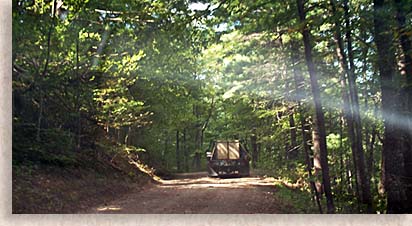 Just west of the town of Vonore, in Monroe County Tennessee, we left the paved highway behind as we entered the Cherokee National Forest and Tellico Lake Wildlife Management Area along a forestry road. Dust at times filled the air as we drove mile after mile into the upper dark forested reaches of the Unicoi Mountains.
Just west of the town of Vonore, in Monroe County Tennessee, we left the paved highway behind as we entered the Cherokee National Forest and Tellico Lake Wildlife Management Area along a forestry road. Dust at times filled the air as we drove mile after mile into the upper dark forested reaches of the Unicoi Mountains.
The Unicoi Mountains are also known as the Lower Unaka Mountains in southeastern Tennessee. The Upper Unaka Mountains are at the northeastern corner of Tennessee and the unofficial central or middle Unaka Mountains are actually the Great Smoky Mountains. These three great Eastern Tennessee Mountain ranges form one long chain bordering Eastern Tennessee. The ancient base rock and exposed rocks of the Unaka Mountains are considered to be from 600-million to 1-billion years old, forming the entire eastern wall of Tennessee's mountain country since time began. The reason for this geology lesson is to kill some time as we travel mile after 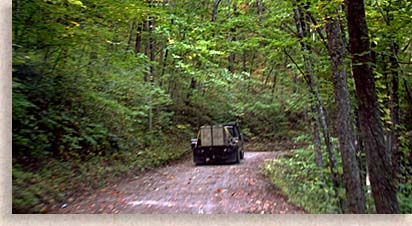 mile into the wilderness.
mile into the wilderness.
Ten miles, fifteen miles, eighteen miles, of eating dust, crossing creeks and streams emerging from our left along the way. All these watercourses we cross along the way join our constant forestry road companion, the Citico Creek as we blaze the interior of the Cherokee National Forest high mountain country. This entire watershed were following, feeds the beautiful waters of Tellico Lake below in Monroe County, Tennessee. At about 20-miles, our mountain guide David Whitehead pulls off the right side of the road and accesses a small clearing surrounded by a heavily wooded forest.
We all pile out of our vehicles stretching our legs a little before preparing for that climatic moment. Taking our chosen photo positions in readiness for this exciting event, we wait patiently as David climbs up onto the truck and prepares for the release. Overcast skies, high above the trees darken the lighting in the already dense forest. Even though it's only late afternoon, the natural lighting at times give the appearance of near twilight.
As David readies to open the two cages, we all take a deep breath. As the cage doors are opened, one of the two bear's dives off the back of the truck then the other, I can't tell which is yearling is which at this point and it doesn't seem to matter. Within seconds, one bear disappears into the woods while it takes the other bear about 30 to 45 seconds to lose sight of us. Home at last, you can only imagine the great euphoria they must feel.
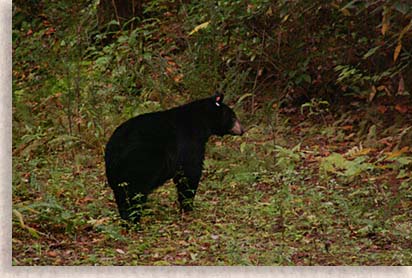 |
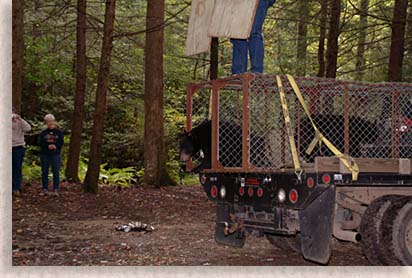 |
From daybreak to release took about eight or nine hours, and it was all over in a matter of seconds. The release of the two yearlings into the wild was our whole focus, yet it was the camaraderie of this unique bear team, the preparation of the yearlings for release, and the spectacle of the cubs in the "care bear center" that made this day so enjoyable.
Yes it was exciting to be a part of the actual bear release, it was a pure and genuine moment in a humanitarian effort that separates us from our wildlife neighbors, or rather brings us closer to them. So much work and care was provided for these young ones, they couldn't do it on their own without the help of the dedicated folks and members at Appalachian Bear Rescue and the Tennessee Wildlife Resources Agency.
We stood around for a few moments making small talk and bidding farewell, vowing to stay in contact with one another. The four bear release crew members in the photo below are from left to right, Anne, Mrs. Highlander, David, and Kathy. We were so deep in the forest, that only our mountain guide, David, had any idea where we were. With accurate directional assistance, and a lot of finger pointing in the air by David. We all bid fond goodbyes as Mrs. Highlander and I, Anne and Kathy, and our esteem wildlife management leader and big bear impersonator David, headed out in three different directions.
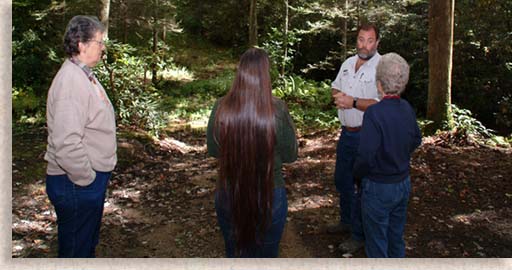 David's directions guided us up the mountain slopes to where we eventually broke out of the dark forest and into the bright sunlight, accessing the scenic Cherohala Skyway, an unexpected treat adding to a very eventful day. The Cherohala Skyway would carry us back eastward over the Unicoi Mountains and into the interior of the Blue Ridge, Smoky Mountains.
David's directions guided us up the mountain slopes to where we eventually broke out of the dark forest and into the bright sunlight, accessing the scenic Cherohala Skyway, an unexpected treat adding to a very eventful day. The Cherohala Skyway would carry us back eastward over the Unicoi Mountains and into the interior of the Blue Ridge, Smoky Mountains.
Along the way home we enjoyed the beautiful mountain vistas surrounding us as we crossed along the heights of the Unicoi Crest. Stopping at one of the overlooks we once encounter our friends, the icons of the mountains, the black bear, depicted on a plaque overlooking a spectacular mountain view.
Today, we came full circle on a journey that was fulfilling, informative and fun. Thanks to the dedicated folks at Appalachian Bear Rescue, the Blue Ridge Highlander has been able to share with its multitudes of readers an adventure so special that it warms the human heart. It's been a long day and Mrs. Highlander and I are as hungry as two bears, and it's another 50-miles before we can reach good food and civilization once again.
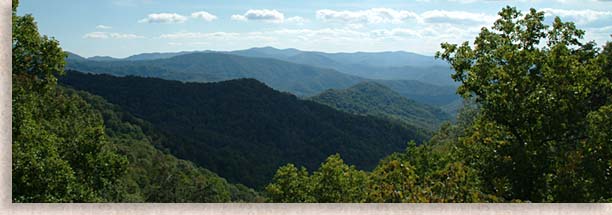
If you have any question about black bear's that hasn't been answered in this Blue Ridge Highlander feature stories, Kings of the Mountains and all it black bear sub stories, you should contact Appalachian Bear Rescue.
Lisa maintains a hotline for notifying the proper authorities for necessary bear cub rescue or recovery at (865) 448-0143. For any other questions and requests, I suggest you visit the website: www.AppalachianBearRescue.org
Why You Should Help!
Before the Appalachian Bear Rescue Organization opened in July 1996, there were no means to care for these helpless cubs. When a mother bear died, or abandoned her cubs, the cubs often died, as well.
Tax-deductible contributions help to keep the ABR's operation alive, providing for the little ones' who can't help themselves. Your contributions can give life to a species of wildlife that are synonymous with the Smoky, Blue Ridge Mountains. The black bears are the living glory of these highlands and they need your help.
Black bears are currently not on the endangered lists, (though Louisiana black bears are on the threatened species list); yet, their numbers are declining and will continue to decline without your support. Little bear cubs lost without their mothers by their side are as helpless as any baby. Private donations are the primary source of funding for the Appalachian Bear Rescue; your help is dearly needed. Donations of at least $50 will receive a 1-year subscription to ABR's quarterly newsletter, "Bear Tracks." For more information on how to donate, visit www.AppalachianBearRescue.org
Your contributions will help this special bear cub rescue mission to evolve and grow. Your generous offers will provide, housing and maintenance items, food and health care supplies, transportation equipment and so much more.
These needy, innocent little cubs, who depended solely upon their bear mothers whom they have lost, now depend on the loving folks like those serving the Appalachian Bear Rescue efforts, to "give them a second chance," to return to nature adding to the cycle of life for these lovable giants of the mountains.
Appalachian Bear Rescue has rescued nearly 100-bear cubs since its official opening in 1996. All cubs and yearlings are prepared for release back into their mountain wilderness home, or in some case where injuries prohibit a natural life in the wild, the ABR relocates them to qualified zoos for further care, it's like one big happy bear family helping one another live better quality lives.
Since Mrs. Highlander and I have been involved in creating this Blue Ridge Highlander feature story, we have been enjoying receiving Appalachian Bear Rescue's quarterly newsletter, "Bear Tracks." This newsletter informs its subscribers about the many accomplishments and activities going on with the ABR throughout the year. The Highlander would like to share with its readers a tender article from one of the newsletter written by curator, Lisa Stewart. It will further help you understand the challenges that face the abandoned, lost or injured black bear cubs.
Bear Tracks... (This newsletter article appeared just before Christmas, 2005. Titled 'Twas 3 nights before Christmas.) When there arose such a clatter! The clatter was ABR's phone ringing off the hook with numerous calls from local, concerned residents. Several Townsend residents had seen a tiny cub in the Tuckaleechee area and were sure it was an orphan. Some residents had actually seen the cub with its mother and a sibling some weeks earlier; but, unfortunately, the story continued that she had been frightened from the area and left with only one of her cubs.
Calls to the Tennessee Wildlife Resources Agency hotline offered immediate assistance and within a few days the cub had been captured and transported to ABR. TWRA officers, Joe Everett and Jeff Pearce, admitted the cub on December 22nd. The cub weighed less than 20-pounds and would not have survived the winter without the help of our competent officers who brought him to ABR.
The cub was appropriately named "Nickolas," (our little St. Nick)! He was welcomed to the bear enclosure by Mimi, (another resident of the enclosure.) ABR "welcome involves some huffing, chomping and bawling! Nickolas settled in a favorite tree. Nick spent his first 2 weeks catching up on some missed meals (he feasts mostly on acorns, but enjoys some treats of fruit and veggies!) By the end of January, Nick had already doubled in size.
Nick spends his days resting high in the treetop and descending at night for a meal. He is resting well, though he has exhibited no interest in denning for the winter (Tennessee black bears don't actually hibernate due to the warm temperatures during our winter months.) He will be monitored through the winter and his release date will be determined in late spring."
This is one of many reality stories that are featured in this informative newsletter. In June 2007, a starved 5-pound weakling cub was admitted to ABR, that's smaller than the average human newborn, the cub was both helpless and motherless. Lisa named him Precious Little Miracle knowing it would take a miracle to pull this little one through. Quoting Lisa from ABR's, Bear Tracks newsletter; "To see his tiny, battered body grow strong and healthy was a thrill for me. With each debilitated bear that is admitted to ABR, I think I've seen the worst. But, Precious Little Miracle was the worst I've ever seen to date and he grew into a big miracle for me to watch. I'm relieved that the close interaction I had with PLM proved to be a benefit and not a detriment to him. With wild animals, one never knows when human intervention can become a curse. Our bears are very courageous and resilient, so I'm glad to know that one-on-one care in a facility where "hands off!" is the normal rule can offer a benefit boost to an orphaned, sick cub that is near death. Though PLM required many extra hours of time and work for me, his recovery was a tremendous success for ABR! Under Lisa's tender loving care the 5-pound weakling grew into a 90.8 bundle of energy in just one season before he was returned to his natural homeland.
We urge you to click www.AppalachianBearRescue.org and sign up for your newsletter today and make a donation to help this worthy cause.
In addition to their newsletter subscribers, the ABR's "Ambassador Donor Program", allows for more involvement by its members. This program allows its supporters to contribute through monetary gifts, while allowing others to be involved in educating the community at large concerning bear safety. Tennessee regulations prohibit volunteers from working with the bears directly (wildlife animals are regulated under restrictions by government agencies.)
To learn more about ABR, check out the Blue Ridge Highlander profile composite page by clicking the link; Mission of the Appalachian Bear Rescue Organization.
The Highlander
Read our other Tales within the Black Bears of the Blue Ridge Smoky Mountains
![]()
Sign
up for the Blue Ridge Highlander Newsletter, Messages from the Mountains
to find out first about our new feature stories, road trips and special offers
Your e-mail addresses will not be sold or given away to anyone.
Privacy
Policy
Interested in your business being on the Highlander, click here...
Let our visitors tell you about the Highlander...
Click the feathers to go to the Highlander site
map...

